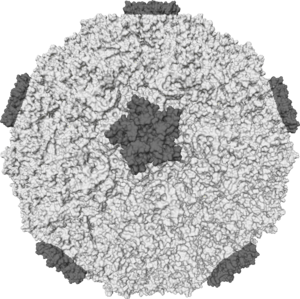Common cauld
The "Scots" that wis uised in this airticle wis written bi a body that haesna a guid grip on the leid. Please mak this airticle mair better gin ye can. |
Common cauld, an aa kent simply as a cauld, is a viral infectious disease o the upper respiratory tract that primarily affects the neb.[7] The throat, sinuses, an vyce box mey an aa be affectit.[5] Signs an symptoms mey begin less nor twa days follaein exposur.[5] Thay include cochin, sair throat, runny neb, neesin, heidache, an fiver.[2][3] People usually recover in seven to ten days.[2] Some symptoms mey last up tae three weeks.[6] In thae wi ither heal problems, pneumonia mey occasionally develop.[2]
| Common cauld | |
|---|---|
| Synonyms | Cauld, acute viral nasopharyngitis, nasopharyngitis, viral rhinitis, rhinopharyngitis, acute coryza, heid cauld[1] |
 | |
| A representation o the molecular surface o ane variant o human rhinovirus | |
| Specialty | Infectious disease |
| Symptoms | Cough, sore throat, runny nose, fever[2][3] |
| Complications | Otitis media, sinusitis[4] |
| Uisual onset | ~2 days frae exposur[5] |
| Duration | 1–3 weeks[2][6] |
| Causes | Viral[7] |
| Seemilar condeetions | Allergic rhinitis, bronchitis, pertussis, sinusitis[4] |
| Prevention | Haund washin, face mask[2] |
| Treatment | Symptomatic therapy,[2] zinc[8] |
| Medication | NSAIDs[9] |
| Frequency | 2–4 per year (adults); 6–8 per year (young childer)[10] |
Well ower 200 virus strains are implicatit in the cause o the common cauld; the rhinoviruses are the maist common.[11] Thay spread throu the air during close contact wi infectit fowk an indirectly throu contact wi objects in the environs follaed bi transfer tae the mooth or neb.[2] Risk factors include gangin tae daycare, nae sleepin well, an psychological stress.[5] Symptoms are maistly due tae the bouk's immune response tae the infection rather nor tae tissue destruction bi the viruses themsels.[12] Fowk wi influenza eften shaw seemilar symptoms as fowk wi a cauld, tho symptoms are uisually mair severe in the umwhile.[5] Influenza is less likely tae result in a rinnie neb.[13]
Thare is na vaccine for the common cauld. The primar methods o prevention are haund washin; nae touchin the een, neb or mooth wi unwashed haunds; an stayin away frae other sick fowk.[2] Some evidence supports the uise o face masks.[14] Na cure for the common cauld exeests, but the symptoms can be treatit.[2] Nonsteroidal anti-inflammatory droogs (NSAIDs) such as ibuprofen mey help wi pain.[15] Antibiotics should nae be uised.[16] Evidence disna support a benefit frae couch medicins.[5]
The common cauld is the maist frequent infectious disease in humans.[17] The average adult gets twa tae fower caulds a year, while the average bairn mey get sax tae aicht.[10] Thay occur mair commonly during the winter.[2] Thir infections hae been wi humanity syne auncient times.[18]
References
eedit- ↑ John, Pramod R. John (2008). Textbook of Oral Medicine. Jaypee Brothers Publishers. p. 336. ISBN 978-81-8061-562-7. Archived frae the original on 29 Mey 2016.
- ↑ a b c d e f g h i j k "Common Colds: Protect Yourself and Others". CDC. 6 October 2015. Retrieved 4 Februar 2016.
- ↑ a b Eccles R (November 2005). "Understanding the symptoms of the common cold and influenza". Lancet Infect Dis. 5 (11): 718–25. doi:10.1016/S1473-3099(05)70270-X. PMID 16253889.
- ↑ a b Bennett, John E.; Dolin, Raphael; Blaser, Martin J. (2014). Principles and Practice of Infectious Diseases (in Inglis). Elsevier Health Sciences. p. 750. ISBN 978-1-4557-4801-3. Archived frae the original on 8 September 2017.
- ↑ a b c d e f Allan, GM; Arroll, B (18 Februar 2014). "Prevention and treatment of the common cold: making sense of the evidence". CMAJ : Canadian Medical Association. 186 (3): 190–9. doi:10.1503/cmaj.121442. PMC 3928210. PMID 24468694.
- ↑ a b Heikkinen T, Järvinen A (Januar 2003). "The common cold". Lancet. 361 (9351): 51–9. doi:10.1016/S0140-6736(03)12162-9. PMID 12517470.
- ↑ a b Arroll, B (Mairch 2011). "Common cold". Clinical evidence. 2011 (3): 1510. PMC 3275147. PMID 21406124.
Common colds are defined as upper respiratory tract infections that affect the predominantly nasal part of the respiratory mucosa
- ↑ "Zinc – Fact Sheet for Health Professionals". Office of Dietary Supplements, US National Institutes of Health. 11 Februar 2016. Retrieved 7 Januar 2018.
Although studies examining the effect of zinc treatment on cold symptoms have had somewhat conflicting results, overall zinc appears to be beneficial under certain circumstances.
- ↑ Kim, SY; Chang, YJ; Cho, HM; Hwang, YW; Moon, YS (21 September 2015). "Non-steroidal anti-inflammatory drugs for the common cold". The Cochrane Database of Systematic Reviews. 9 (9): CD006362. doi:10.1002/14651858.CD006362.pub4. PMID 26387658.
- ↑ a b Simasek M, Blandino DA (2007). "Treatment of the common cold". American Family Physician. 75 (4): 515–20. PMID 17323712. Archived frae the original on 26 September 2007. Retrieved 23 Mairch 2017.
- ↑ "Common Cold and Runny Nose" (17 April 2015). CDC. Retrieved 4 Februar 2016.
- ↑ Eccles p. 112
- ↑ "Cold Versus Flu". 11 August 2016. Retrieved 5 Januar 2017.
- ↑ Eccles p. 209
- ↑ Kim, SY; Chang, YJ; Cho, HM; Hwang, YW; Moon, YS (21 September 2015). "Non-steroidal anti-inflammatory drugs for the common cold". The Cochrane database of systematic reviews. 9: CD006362. doi:10.1002/14651858.CD006362.pub4. PMID 26387658.
- ↑ Harris, AM; Hicks, LA; Qaseem, A; High Value Care Task Force of the American College of Physicians and for the Centers for Disease Control and, Prevention (19 Januar 2016). "Appropriate Antibiotic Use for Acute Respiratory Tract Infection in Adults: Advice for High-Value Care From the American College of Physicians and the Centers for Disease Control and Prevention". Annals of Internal Medicine. 164: 425. doi:10.7326/M15-1840. PMID 26785402.
- ↑ Eccles p. 1
- ↑ Eccles, Ronald; Weber, Olaf (2009). Common cold. Basel: Birkhäuser. p. 3. ISBN 978-3-7643-9894-1.